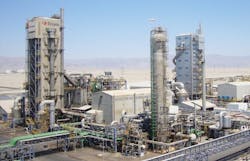Avina signs up Offtakers for 100% of future Green Ammonia production in Texas
Green hydrogen platform Avina Clean Hydrogen has inked long-term offtake agreements for the entire production from the first phase of the green ammonia facility currently under development on the Texas Gulf Coast.
Powered with 100% renewable power, the facility is expected to begin operations in 2025 and produce 100,000 metric tons of green ammonia under the first phase, Avina says. Total capacity will be increased to 700,000 metric tons per year in the second phase, it adds.
Once operational, Avina hopes that the facility will make US a key exporter of green ammonia to global markets such as Asia, Europe and South America.
The plant is part of the company’s plans to invest $1 billion in hydrogen and green ammonia facilities by 2025. Additionally, Avina says it has a pipeline of a further 1.5 GW of renewable energy assets that can be transformed into green hydrogen projects.
“This is a significant milestone for our green ammonia facility that has been under development for more than 18 months now. With abundant renewable energy resources and best-in-class maritime infrastructure, the Texas Gulf Coast region is an ideal location for this production facility,” said Vishal Shah, Founder and CEO of Avina Clean Hydrogen.
Avina aims to expand the use cases for renewables by leveraging low-cost renewable electrons and turning them into higher value green molecules.
Green ammonia (NH3) can be created from water electrolysis, powered by renewable electrolysis, and nitrogen separated from the air. Ammonia has four hydrogen atoms and one nitrogen. The traditional, carbon intensive way to create ammonia is through steam methane reforming to make hydrogen and create the NH3 from that.
Ammonia is used to make fertilizers for agriculture and an energy carrier. Up to 20 percent of greenhouse gas emissions come from the agriculture industry or land use sector, according to reports.
About the Author
EnergyTech Staff
Rod Walton is senior editor for EnergyTech.com. He has spent 17 years covering the energy industry as a newspaper and trade journalist.
Walton formerly was energy writer and business editor at the Tulsa World. Later, he spent six years covering the electricity power sector for Pennwell and Clarion Events. He joined Endeavor and EnergyTech in November 2021.
He can be reached at [email protected].
EnergyTech is focused on the mission critical and large-scale energy users and their sustainability and resiliency goals. These include the commercial and industrial sectors, as well as the military, universities, data centers and microgrids.
Many large-scale energy users such as Fortune 500 companies, and mission-critical users such as military bases, universities, healthcare facilities, public safety and data centers, shifting their energy priorities to reach net-zero carbon goals within the coming decades. These include plans for renewable energy power purchase agreements, but also on-site resiliency projects such as microgrids, combined heat and power, rooftop solar, energy storage, digitalization and building efficiency upgrades.
